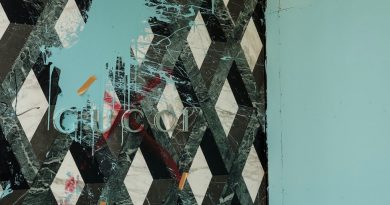Couture’s Brave New World | BoF
PARIS — Cristobal Balenciaga needed a fabric that would hold his incredible shapes, something he could sculpt. In 1958, Gustave Zumsteg, fabric designer for the Abraham textile company, invented gazar for him. It became the iconic cloth of couture. Fast forward 64 years, and Demna is offering his idea of gazar in the opening passage of Balenciaga’s 51st couture collection: bodysuit, scuba dress, coat, jacket and five-pocket leggings.
The material is a Japanese neoprene, treated with limestone, which guarantees its eco-status. It’s as difficult to work with as gazar. Demna claims he needed his petites mains to put the pieces together, almost mould them, in fact. His models wear them with “a couture face shield” in coated polyurethane, made in partnership with Mercedes-AMG Formula One.
:quality(70)/cloudfront-eu-central-1.images.arcpublishing.com/businessoffashion/WN5XRBHQJRDAHEYVQ6BH4KWY4I.jpg)
It’s a stunning opening gambit, this handful of living organisms so smooth, featureless, sexless and insectoid. A new New Look! Demna says it’s a natural evolution, he’s following his instinct, putting more of himself in Balenciaga. There’s a voice on the soundtrack whispering “Je t’aime.” He claims they’re the most beautiful words he knows. Strings swell in accompaniment, filling last season’s silence. Demna’s partner Loik Gomez, who records as BFRND, and contemporary composer Gustave Rudman Rambali collaborated on the soundtrack, recording it with an orchestra in Budapest. Real strings! “The couture level of soundtracks,” Demna enthuses.
The ingenuity of the collection demands more scrutiny than a walk-by in a fashion show can provide, however stately its pace. In that, it occasionally recalls the work of Martin Margiela, where Demna spent four years. But when he winds up the presentation with an exercise in what he calls pure heritage, his instinctive grasp of Cristobal’s austere extravagance crystallises. The climax is a huge Infanta wedding dress, so wide the model has trouble manoeuvring around the doorways of the Balenciaga salon. “It’s the whole gradation of how I see couture,” says Demna. But it plays in reverse, from a futuristic metaverse to a Velasquez portrait of the Spanish court in the 17th century.
Cristobal famously stirred irrational passion in his clientele of society belles. As the belles of Demna’s 21st century court — Kardashian, Kidman, Campbell, a Hadid, a Lipa — parade by in their grand gowns, it’s happening again. But it is now, not then. This collection includes a T-shirt, oversized for couture drama. Its layer of aluminium gives it a memory. There are parkas and jeans made from reassembled, upcycled vintage parkas and denims. More memories, transmogrified.
:quality(70)/cloudfront-eu-central-1.images.arcpublishing.com/businessoffashion/5UNWRJ3KAFAKJEDIP3DA4OSUCE.jpg)
They highlight the emotion that is embedded in Demna’s vision. Maybe the whole show is a love letter, with that lush soundtrack to set the mood. “Couture is the only thing I love doing,” he declares. “I wanted to express that verbally, which I don’t often do, to say I love this métier, and this is the reason why I showed today what we showed.” But it’s a personal love letter too. Just over halfway through, the face shields drop and we see human features for the first time. It’s Loik.
Dior’s Maria Grazia Chiuri would appreciate the emotional impact of such a moment, but she is a planet apart in her own evolution. She did, however, address the current moment by taking inspiration from the work of Olesia Trofymenko, a Ukrainian artist whose favourite motif, the Tree of Life, is a folkloric symbol of humanist hope in cultures all over the world. Trofymenko embroiders on paintings. The Dior venue was lined with huge wall panels of exactly that, embroidered by the Indian company Chanakya, with whom Chiuri has worked since her days at Fendi. The same level of traditional handcraft saturated the collection.
:quality(70)/cloudfront-eu-central-1.images.arcpublishing.com/businessoffashion/BXM3SEQU3JFMHIOBMS6VV4TAKU.jpg)
Chiuri had in her mind the fact that Christian Dior founded his house in the aftermath of the most traumatic war Europe had ever experienced. His reaction was the explosion of the New Look, a radical beauty that ravished sensibilities starved of it. Obviously, we are nowhere near the trauma of those distant decades – yet! – so Chiuri’s collection was a muted affair, delivered in white, black, beige and greige, with an emphasis on intimacy and grace.
If it could tell a story, it would probably be a folk tale. The models solemnly walked with hair bobbed or cropped or braided, faces aglow, like a small army of Joan of Arcolytes. Dresses flowed floorwards, with full or fluted sleeves. They were occasionally draped in elaborately embroidered coats or capes (Chiuri’s signature style has always been these romantic princess looks). Other dresses, mid-calf, were like less elaborate folk costumes. But God was truly in the details here, in the subtle but rich tone-on-tone embroideries, in the patchworks of lace, which looked almost tea-dyed, a humble effect which you knew had been achieved with the very heights of couture workmanship.
:quality(70)/cloudfront-eu-central-1.images.arcpublishing.com/businessoffashion/UPUPJUQVVVA2FIE66M3AUON4IU.jpg)
The hyper-waisted Bar jacket has been Christian Dior’s benchmark item since he first showed it in 1947. It’s been the easiest way to judge his heirs’ response to his legacy: what do they do to the Bar? Chiuri has eased it, softened it, be-denimed it in her time at Dior. Here, she shaped it with hand-smocking, another folkloric flourish. “Traditions and gestures that allow us to recover a balance,” she explained, “if only momentarily.” Maybe when that moment passes, there’ll be a radical New Look in her future.

